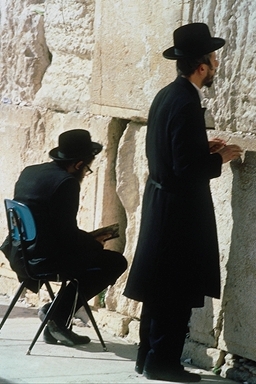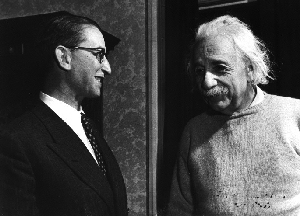|
 Origins
The known origins of Jewish music
go as early as the Temple in Jerusalem and the ritual that served in it.
After departure from the holy land to exile, Judaism prohibited secular
music, but the synagogue remained a place of singing. Some of taamey ha-mikra
(traditional signs on Hebrew bibles), according to which the verse and
prayers are read, are chanting signs.
During the many years of exile,
there were almost no Jewish composers, except for Solomon
Rossi Origins
The known origins of Jewish music
go as early as the Temple in Jerusalem and the ritual that served in it.
After departure from the holy land to exile, Judaism prohibited secular
music, but the synagogue remained a place of singing. Some of taamey ha-mikra
(traditional signs on Hebrew bibles), according to which the verse and
prayers are read, are chanting signs.
During the many years of exile,
there were almost no Jewish composers, except for Solomon
Rossi ,
who tried to write tunes for prayers, but this was rejected by Rabbis.
Nevertheless, foreign influences from Gentile
environments and the Christian Church kept on being absorbed into sacred
songs and prayer versions. Jews of Islamic
countries were also exposed to Arab singing and playing, the characteristic
scales and oriental ornaments, and Jewish prayers were enriched by a variety
of melodies sung with a clearly Eastern style ,
who tried to write tunes for prayers, but this was rejected by Rabbis.
Nevertheless, foreign influences from Gentile
environments and the Christian Church kept on being absorbed into sacred
songs and prayer versions. Jews of Islamic
countries were also exposed to Arab singing and playing, the characteristic
scales and oriental ornaments, and Jewish prayers were enriched by a variety
of melodies sung with a clearly Eastern style .
Today, the state of Israel has
a fascinating encounter with the different musical cultures where Jewry
existed, and chanting prayers in the various versions is one of the experiences
of this melting pot. Most Israelis believe that only pluralism and recognition
of every musical culture's beauty will bring about a true human merger,
and the entire variety of prayer forms and liturgical songs are to be preserved
and nurtured. .
Today, the state of Israel has
a fascinating encounter with the different musical cultures where Jewry
existed, and chanting prayers in the various versions is one of the experiences
of this melting pot. Most Israelis believe that only pluralism and recognition
of every musical culture's beauty will bring about a true human merger,
and the entire variety of prayer forms and liturgical songs are to be preserved
and nurtured.
Klezmer
Jewish instrumental music developed
in Eastern Europe
from the 15th century, when Jewish "Klezmer" bands excited and
rejoiced Jews in the Diaspora, as well as the Christians in their surroundings.
This music, played at Jewish weddings and
other family events, is based on improvisation and folk tunes transmitted from father to son, instead of via accurate notation.
The writer Y.
L. Peretz best describes this music in his
Hassidic stories; after the Second World War and the near complete annihilation
of Eastern European Jewry, it became a symbol of a lost civilization.
The main instruments in this music
were the violin
transmitted from father to son, instead of via accurate notation.
The writer Y.
L. Peretz best describes this music in his
Hassidic stories; after the Second World War and the near complete annihilation
of Eastern European Jewry, it became a symbol of a lost civilization.
The main instruments in this music
were the violin ,
the trumpet ,
the trumpet and the double
bass
and the double
bass .
But since the 20th century, the clarinet .
But since the 20th century, the clarinet took a central role in the "Klezmer"
music, and the expression capacity clarinetists manifest, the human emotion
- from laughter to crying - have placed it in the center of this Jewish
"soul music". Nowadays, players such as Giora
Feidmann, Albert
Piamenta and Israel
Zohar
took a central role in the "Klezmer"
music, and the expression capacity clarinetists manifest, the human emotion
- from laughter to crying - have placed it in the center of this Jewish
"soul music". Nowadays, players such as Giora
Feidmann, Albert
Piamenta and Israel
Zohar perform this music regularly and have won many fans for this style all
over the world. The annual Klezmer festival in Safed,
the Galilee, is a good occasion to meet this music in it's natural environment.
Hassidic music is alive!
perform this music regularly and have won many fans for this style all
over the world. The annual Klezmer festival in Safed,
the Galilee, is a good occasion to meet this music in it's natural environment.
Hassidic music is alive!
 Israeli
Music
Serious music in Israel evolved
alongside the immigration of active composers, even before the Israeli
State's establishment. Composers of this founding
generation, such as Paul Ben-Haim Israeli
Music
Serious music in Israel evolved
alongside the immigration of active composers, even before the Israeli
State's establishment. Composers of this founding
generation, such as Paul Ben-Haim ("Israel Plays"),
Menahem Avidom
("Israel Plays"),
Menahem Avidom (the "Folk" symphony),
Uriah Boskowitz
("Semite Suite")
and Eden Partosh
("Visions")
- all created 20-century music, with reference to global trends, combined
with elements of Middle East
music: ancient modes,
typical rhythms, ornamentation, trills, and so on.
Among the composers of the second
generation, like Noam Sharif
("Confession" for cello),
and Haydu, who
studied the musical folklore of different Jewish communities ("Mishnaiot"
and "A King's Hail"),
the tendency of turning to ethnic sources developed further, but others
turned to different directions: the composer Menahem
Zur turned to electronic
music ("Hymns"
on a magnetic tape), and Yitzhak
Sadai turned to electro-acoustic
music.
(the "Folk" symphony),
Uriah Boskowitz
("Semite Suite")
and Eden Partosh
("Visions")
- all created 20-century music, with reference to global trends, combined
with elements of Middle East
music: ancient modes,
typical rhythms, ornamentation, trills, and so on.
Among the composers of the second
generation, like Noam Sharif
("Confession" for cello),
and Haydu, who
studied the musical folklore of different Jewish communities ("Mishnaiot"
and "A King's Hail"),
the tendency of turning to ethnic sources developed further, but others
turned to different directions: the composer Menahem
Zur turned to electronic
music ("Hymns"
on a magnetic tape), and Yitzhak
Sadai turned to electro-acoustic
music.
|